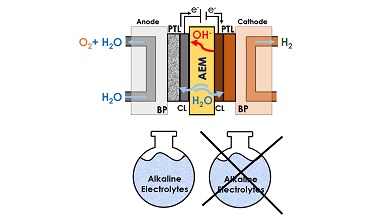
Hydrogen is a clean and sustainable energy carrier that supports the large-scale integration of intermittent renewable energy sources, provides renewable fuels for heavy-duty transportation, and enables deep decarbonization of hard-to-abate industrial sectors. Among various water electrolysis technologies, anion-exchange membrane water electrolyzers (AEM-WEs) offer several actual or anticipated advantages. These include the use of non-precious metal electrocatalysts at both electrodes, fluorine-free hydrocarbon-based ionomer membranes, and cost-effective materials for bipolar plates. Unlike proton-exchange membrane water electrolyzers (PEM-WEs), which operate using pure water without added electrolytes, current AEM-WEs require the circulation of a dilute alkaline electrolyte to achieve high energy efficiency and durability.
However, operating AEM-WEs with pure water—i.e., without added alkali—is highly desirable due to multiple factors such as reduced balance-of-plant costs, lower operational expenses, and enhanced system longevity.
The comprehensive review entitled “Anion-Exchange-Membrane Electrolysis with Alkali-Free Water Feed” (doi: 10.1021/acs.chemrev.4c00466) recently published in Chemical Reviews (American Chemical Society, Impact Factor 55.8, 2024 Journal Impact Factor, Journal Citation Reports (Clarivate Analytics, 2025)) aims to establish a fundamental understanding of AEM-WE performance under pure water conditions and explores the potential for using natural water sources such as seawater. In this work the advantages of operating AEM-WEs with pure water are outlined, then the relevant thermodynamic and kinetic processes delved. A comprehensive examination of the system’s components—including membranes, ionomers, electrocatalysts, porous transport layers, bipolar plates, and overall system architecture—is provided, with particular attention to how electrolyte composition and alkali-free feeds impact their performance. Finally, the degradation challenges introduced by pure water operation are discussed and strategies to mitigate these issues are proposed.
This work was carried out by Dr. Mohsin Muhyuddin, Prof. Piercarlo Mustarelli and Prof. Carlo Santoro (Department of Materials Science, University of Milano-Bicocca), Luigi Osmieri (Los Alamos National Laboratory), Valerio C.A. Ficca (ENEA), Ariel Friedman (University of Connecticut), Karam Yassin and Dario Dekel (Technion), Lior Elbaz (Bar Ilan University), Gioele Pagot, Enrico Negro, Vito Di Noto (University of Padua), Anastasiia Konovalova (DTU), Grace Lindquist, Liam T., and Minkyoung Kwak (University of Oregon), Frédéric Jaouen (University of Montpellier), Shannon Boettcher (University of Oregon and University of California Berkeley), Enrico Berretti and Alessandro Lavacchi (CNR-ICCOM, Firenze) and Plamen Atanassov (University of California Irvine).
This publication is licensed under CC-BY 4.0.